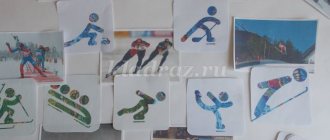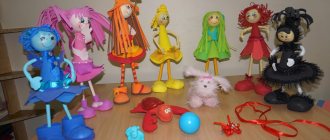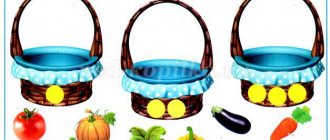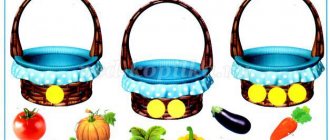"Ladybugs"
Material: cards with the image of ladybugs with a number on the left wing; numbered cards for the second wing; numbers in circles.
Options for using the guide:
1. The teacher places a number in a circle above the ladybugs and invites the children to choose a number for the second wing. The child finds this number and attaches it to the wing.
2. The numbers are located on both wings of the ladybugs. The child needs to make a number from two numbers and find the corresponding number in the circle.
"Amanita"
Material: fly agaric caps are double-sided: white dots are glued on one side (from 1 to 10, on the other - examples; fly agaric paws with numbers from 1 to 10; white and red circles.
Options for using the instructions: 1. “Choose a stem for a hat from a fly agaric”: the task is considered completed correctly if the number of points on the hat matches the number on the stem.
2. “Solve examples”: you need to solve arithmetic examples (on the lid of the fly agaric) and find the answer (the number on the leg of the fly agaric). The task is considered completed successfully if the arithmetic example is solved correctly.
“Equal - unequal” The presenter casually places his feet on the fly agaric caps. Often the numbers on the legs do not correspond to the number of points on the caps. The child must match the number and number of points using double-sided counters. To do this, he covers the extra points on the hat with the red side of the chip and adds the missing points with the white side of the chip. The task is considered correctly completed if the number of points on the hat matches the number on the leg.
"At home"
Material: Houses with windows. There is only one room on each floor. Set of numbers.
How to play: The number on the roof indicates the number of inhabitants on each floor. The child must select and enter a number in the second window.
“Match the wheels to the car” Options for using the guide:
1. The car is given a number. Children must match the wheels to the car so that the number of dice on the two wheels, indicated by the numbers, is the number shown on the car (select all options).
2. Numbered wheels are placed on the car and the child must determine the total number of wheels and put the corresponding number on the car.
"Polyanka"
Material: Polyanka (in green cardboard); 2 types of box colors; Velcro in the center for fixing numbers on the clearing.
How to play: A number is placed in the center of the clearing. The child must make this number from flowers of different colors.
Didactic games on number composition for preschoolers
"Remove the number"
The game develops attention, reaction speed, thinking, dexterity, and strengthens counting skills.
We lay out cards with numbers from 0 to 10 sequentially. The adult sets the task, and the child must complete it. For example, “Remove the number 7”, “Remove the number between 2 and 4”, Remove the number that is greater than 3 by 2, etc.
Tasks can be given in the form of riddles, the answer will be the number that needs to be removed.
"What number is missing"
The child names the missing number. During the game, we consolidate knowledge of numerical counting from 0 to 10 and train attention.
"Confusion"
During the game, we consolidate knowledge of numbers, counting from 0 to 10 in forward and reverse order, as well as attention and memory.
We put the numbers in order, then the child turns away, and the adult changes their places. The child’s task is to find and correct the mistake.
"Which number escaped"
The game is similar to the previous one, the difference is that the numbers (1,2) are removed. The child must say which number is missing and where it was. For example, no 4 it stood between 3 and 5.
"Name your neighbor"
The game will also help consolidate knowledge of counting from 0 to 10 in forward and reverse order. To play you will need cards with pictures of trailers, numbers are written in the boxes, one box is not labeled. The child’s task is to name the missing number. If the game takes place in a children's group, then you can transform it into a competition. Who can name the correct answer faster?
"Let's count"
Ball game for 2 players. With the help of the game we strengthen the ability to count forward and backward.
Before the game we agree on the order of the score. We throw the ball around in a circle and count, the counting pace should be fast.
"Ladder"
The game helps develop the child’s understanding of the sequence of numbers and the ability to compare them.
We consider a numerical ladder (pre-built from a construction set or drawn on paper). We count the steps (direct and reverse order), name the smallest threshold, then the largest one - compare, then compare the others with each other.
Game “Sweet Palms”
Speech exercise:
We will knead our fists, clench and unclench them (at the same time clenching and unclenching our fists), And then-then-then...we will take some sweets and put a little of them on each palm.
Option 1.
The specified number of candies is distributed on both “palms” in all possible options, which are then spoken out.
Option 2.
The child collects the specified number of candies on one of the “palms”. Closes his eyes. The teacher quickly places some of the candy under the other palm. When the baby opens his eyes, he must remember how many candies there were and how much the bear (bunny, etc.) “ate”. He can check his answer on his own by looking under the other palm. Note. You can invite the child to draw on the second palm the number of allegedly eaten sweets, and then compare the result.
Publication address:
How to teach a child the composition of numbersconsultation (preparatory group)
Starting to learn and study numbers and counting, the child is faced with the concept of the composition of a number. Many parents do not think about it and do not pay attention to this when they are memorizing sequences. However, studying the composition of numbers will speed up memorization, as well as the child’s understanding of the principle of number formation.
When should you start explaining to a preschooler what the composition of a number is?
At the age of 5-6 years, children already know numbers well and become familiar with simple arithmetic operations. It is during this period that it is worth spending a little time on exercises and explaining to the child the composition of numbers up to 10. However, it is important that the child has already mastered:
- direct verbal counting to 10;
- count down from 10 to 1;
- recalculation and counting of objects;
- composition of a number by units (for example, 2 consists of 1 and 1, 3 – of 1 and 1 and 1).
All these skills indicate that the child can already explain the composition of any number within 10.
What is useful for homework?
Classes will become more effective if you prepare in advance and collect the necessary training material:
- counting sticks;
- game cubes;
- cards with images of numbers;
- multi-colored pebbles or buttons;
- abacus;
- houses for numbers.
You can purchase ready-made educational kits at stationery or toy stores, or make all the necessary items together with your child. The second option is preferable.
Effective techniques
The composition of the number 10 needs to be explained gradually, dividing the training into several logical blocks. In the first lessons, you should pay attention to the numbers 2 and 3, their relationships and possible combinations. Then you can move on to classes with visual cards and only then connect number houses.
Lesson 1: mastering the numbers 3, 2, 1
Take your baby's favorite toys and things (blocks, dolls, cars). Start the exercise by analyzing the number 2 and show your child how it can be obtained:
- Place one object on the table in front of the baby and ask the child to make it become two. Usually it is not difficult for him to figure out how to cope with the task. If necessary, give a hint.
- Explain to your child that 2 is a number that always consists of a pair of ones.
- Ask your child to place 2 of their favorite items on the table.
- When the two is fixed, move on to studying the three. Tell your child that if you add 1 to 2, you get 3. Place two coins in front of him and another one next to him. The child must learn that there is no difference between 3 coins together, 2 with 1 or 1 with 2.
Gradually make the task more difficult. Getting a four in a game is as easy as getting a three. Chess or checkers can help here. Invite your child to choose 2 shapes of the same color (white), and then repeat the task. Ask: How many chess pieces will remain if 1 light chess is replaced by 1 dark one? What happens if you combine 2 black and 2 white pieces? In the end, he should understand that the number 4 can be obtained with every possible permutation.
It is worth moving on to the next block of tasks when the child understands that all these actions will lead to a result known in advance:
- 2 is 1 + 1, 2 + 0;
- 3 is 2 + 1, 1 + 2, 3 + 0;
- 4 is 1 + 3, 2 + 2, 3 + 1, 4 + 0.
Using the same principle, explain the remaining numbers up to 10.
Task 2: number cards
At this stage, the child should already understand that by adding different numbers, you can get any result. But when you need to find out the composition of a certain number, you need to go from the opposite - from a predetermined answer. You need to work with him to sort out all the pairs of terms that lead to a single result. Number cards are great for this. There are several training options:
- Draw, for example, 5 butterflies on the cards and invite the child to collect the required number from the proposed blanks.
- Invite him to collect combinations on his own several times, in which their total will ultimately be equal to 5.
- Ask your child to tell you how to get a number. Make mistakes, kids will have to use all their abilities to figure them out.
You should begin the last block of tasks when the child can select all the options for the composition of the specified number.
Task 3: number houses
Arithmetic houses are great for helping to finally understand and consolidate in a child’s knowledge the concept of the composition of any number, as well as to develop the skill of mental calculation.
A house for numbers is a building with a roof and several floors with apartments in two rows. The height of the structure depends on the number to which you need to select all possible combinations of numbers. To explain to a child the composition of the number 2, it is enough to draw a house with two floors (0+2, 1+1) and so on.
House blanks can be found in mathematics textbooks or you can make them yourself from cardboard.
How to structure a lesson:
- Place an empty house on the table, placing a card with a number from 2 to 10 (let it be 6) in its roof.
- Explain to your child that on each level there are as many people in the apartments as are written on the roof.
- Set the condition: only one person lives in 1 apartment on the ground floor. The kid needs to think and determine how many residents live in apartment number 2 (the correct answer is 5).
- Now that the algorithm for solving the problem is clear, ask the child to populate all the remaining apartments, changing the initial number of residents on each new floor. As a result, there will be 2 and 4 residents on the 2nd floor, 3 and 3 on the 3rd floor, 0 and 6 on the 4th floor. Thus, the baby will be able to master all existing combinations of numbers.
A small life hack: tell us that any number always consists of 1 and the previous digit in order. So, if you want to find out the composition of the number 7, the first answer is immediately ready: 7 is 1 and 6.
When all pairs of numbers and the composition of 10 are mastered, you can complicate the tasks.
Exploring the twenties
If you managed to explain to your child what the mathematical composition of a number is, then you should move on to one of the most difficult moments - working with tens. The kid will definitely ask why 6+5=11, which is why it is called and written like that. First of all, tell us that for convenience, large numbers are counted as tens. For example, 6 and 4 are one ten. Since the problem required adding 5, and we have already added 4, then only one is missing. Therefore it turns out:
- 6+5 is 6+4 and 1 more;
- 6+4=10;
- We write the last unit instead of 0, it turns out 11.
At first, the child will not understand anything, but after a while he will learn the basic principle of working with tens. You can make the problem easier with a visual exercise:
- ask to count out 10 candies and put them in one bowl;
- now you need to put 7 more treats in another container;
- under each bowl you should place a card with the image of a number corresponding to the number of candies;
- ask your child to add everything together and tell him how many candies he got;
- for better understanding, explain that 10 in two-digit counting means 1;
- correct option: the child writes one and 7 next to it, which means 17.
Similar examples can be carried out with a large number of objects. For example, a preschooler should know that 32 is 3 tens plus 2 more units.
How to help a child?
Numbers from 2 to 10 are very common in everyday life, and learning to count is largely a creative process. It’s easy to help with mastering numbers even without purchasing special devices:
- Does your child like sports? Count the number of goals scored with him.
- Does your child love nature? Look at the trees on the lawn, compare on which side there are more of them and on which side there are fewer.
- Does your child constantly draw something? Invite him to draw a certain number of objects on the sheet. Are you into sculpting? Ask to make a figurine with 3 legs, 2 tails and 1 ear.
- Be cunning. Throughout the day, ask your child “if I take one cookie from you, how many will you have left?” and the like.
In a comfortable gaming atmosphere, the child will quickly figure out the composition of all the numbers and will count 1 2 3 4 5 and up to ten correctly.
If your baby is not good at mental math, then we can assume problems with thinking, attention or lack of concentration. Games from BrainApps will help you direct your energy in the right direction. The service offers over 100 simulators that allow you to develop and improve your intellectual skills.
capabilities. After registering on the site, select the required category of games:
- To improve memory. Trainers such as “Numeric Spanning”, “Memorize and Click” and “Find a Pair” will develop memory capacity, improve its accuracy and improve attention span.
- To develop thinking. The games “Fruit Mathematics”, “Comparing numbers from memory” and “Moving” will improve visual and spatial memory, develop logic and teach the child to quickly find answers to questions.
- To improve attention. The “Find the Shape”, “Space” and “Concentration” simulators will help your child concentrate better and direct attention in the right direction.
Playing games online with your preschooler is not only a fun, but also a useful hobby. The child will be able to develop, achieve his goals and compete with you or his peers. All you need is a network connection and free time.
Recommendations for parents
Understanding the importance of explaining the composition of numbers, try to adhere to the proposed recommendations that will help your preschooler calmly master and remember new information:
- Everyone has crises, but we must remember that this is a temporary phenomenon.
- Let's have more freedom. Often the parents' demands do not correspond to the child's capabilities. Think about whether all your prohibitions are justified.
- Consider children's opinions. It is necessary to clearly understand that a preschooler has his own opinions and judgments. Try to accept them.
- Forcing is ineffective. Edification and commanding tone during classes will not give a positive effect. If your child doesn’t want to learn numbers and examples with the numbers 1 2 3 seem scary to him, find out what the reason is. Explain why and why you need to study.
- Patience and optimism are your best companions. A good mood, an atmosphere of love, support and mutual understanding direct aspirations in the right direction.
It is also recommended to adhere to a strategy of positive assessment of the baby:
- Show your friendly attitude.
- Find and analyze errors together.
- Discuss options and solutions to errors together.
- Support and express confidence that he will definitely succeed.
Don’t forget to consolidate your results and include educational cartoons and other videos in your training program.
Material selected: internet source
Every number can be made from two numbers
The next step in teaching is to let your child understand that every number can be made up of two numbers, each of which is smaller than itself. For example, two is 1 and 1, and four is 1 and 3 or 2 and 2. Make all possible combinations, for example, five can be represented as 2 and 3 or 3 and 2. At the same stage, include in the composition of the numbers zero: each of them can be counted as the sum of itself and zero: three is 0 and 3 or 3 and 0.
Let the child remember one of the first arithmetic rules: Any number can be represented as the sum of 0 and the same number.
Also use objects in teaching - this will make it easier for a preschooler to understand the principle of decomposing numbers into individual components, and in the future he will be able to count without problems. Later you can move on to written exercises. One of the most famous is the “Number House”. On each floor of this conventional house there are two apartments, and only a certain number of people can live in them, for example, only 4. Together with your child, “populate” the residents in apartments, making sure that their total number (the number in the window) does not exceed specified in the task. An adult can write numbers in the boxes at first, but such activities are an excellent opportunity for a child to get acquainted with what numbers look like on paper or a computer screen and to practice writing them.
Captains lived in these houses. One day all the captains quarreled and left their “apartments”. We must reconcile them and put them back in their “apartments.”
Look what number is written on the roof of this house? (5)
How many captains should live on each floor? (5)
(Each child works on the composition of the number 5. And the child who completed it the fastest displays this composition of the number in a large house
).
Instead of a house, you can use other pictures, for example, a Christmas tree with Christmas toys. You can draw the images yourself, download them from the Internet, or adapt regular coloring books for classes.
After graphic exercises, the child will be ready to perform a similar decomposition in his mind, without using fingers or other objects. This means that in the future he will be able to do mental calculations without problems in mathematics.
Nice bonus: Exercise Missing numbers (76.2 KB)
so UNT / Lesson developments / Lessons in Mathematics
Mathematics 1st grade. Topic: Composition of the number 6.
24.11.2014 3063 0
Purpose: Familiarization with the composition of numbers6.
Objectives: 1. To develop students’ knowledge about the composition of the number 6. Learn to write the number 6.
2. Develop mathematical thinking, memory, attention, speech development, and correctly read the corresponding equations.
3. Foster friendship, collectivism, and interest in the subject.
Expected results. :1. Students will develop knowledge about the composition of the number 6. They will learn to write the number 6.
2. Develop mathematical thinking, memory, attention, speech, and correctly read the corresponding equations.
3. Develop friendship, collectivism, and interest in the subject.
Equipment: counting line, demonstration numbers, figures for assessment, houses for filling in the composition of numbers.
During the classes.
1.Org moment. Emotional mood. Musical warm-up.
2. Main part. Division into groups. On the teacher's desk there are stickers with the numbers 1.2.3.4.
Children take them apart and sit in groups.
- Guys, today the numbers in the number series have a problem. The wizard accidentally made a mistake and enchanted a number, and I can’t figure out which one.
- Look at the number series and tell me what number it is. (Number 6).
- To disenchant her, we need to complete the wizard’s tasks. For each correctly completed task, the wizard will give you a magic star.
3. And so we begin.
"Brain attack" Oral calculation.
- name the number that follows the number 2.4,5,1,0
- what number will you get if 5 is 1?
- name a number that is between 2 and 3, 8 and 10, 1 and 3, 4 and 6
- we added 1 to the intended number, we got 3. What number did we have in mind?
Well done, Assessment.
4. Repetition of the composition of numbers 4.5 work in groups.
Two groups fill the houses according to the composition of the numbers. They defend their work, compare and evaluate each other.
5. Work on studying the composition of the number 6.
The guys have counting sticks on their desks.
- arrange the sticks into two piles in different ways so that the result is the number six, and write down the results on sheets of paper.
The guys do the work, demonstrate results, evaluate each other, and receive stars.
Comparison of work results with a visual aid on the composition of numbers.
6. Work according to the textbook. Page 44.
— No. 1 work in pairs. Fill in the cells. Checking, evaluation.
No. 2 Compiling and reading equalities.
No. 3. Give the missing numbers.
7. Work in a notebook. Repeated writing of the number 6. Mutual assessment. Children draw a star for each other in the margins.
Completing a comparison task. Two at the board.
7. Generalization.
-Well, we have completed the tasks. Look at the number line. What happened?
What did we learn today? (composition of number 6).
8 Reflection. We did a good job today. You received stars from the wizard. Where do the stars live?
Let's put stars on the sky. (Children stick stars on the starry sky)
9. Lesson summary.








